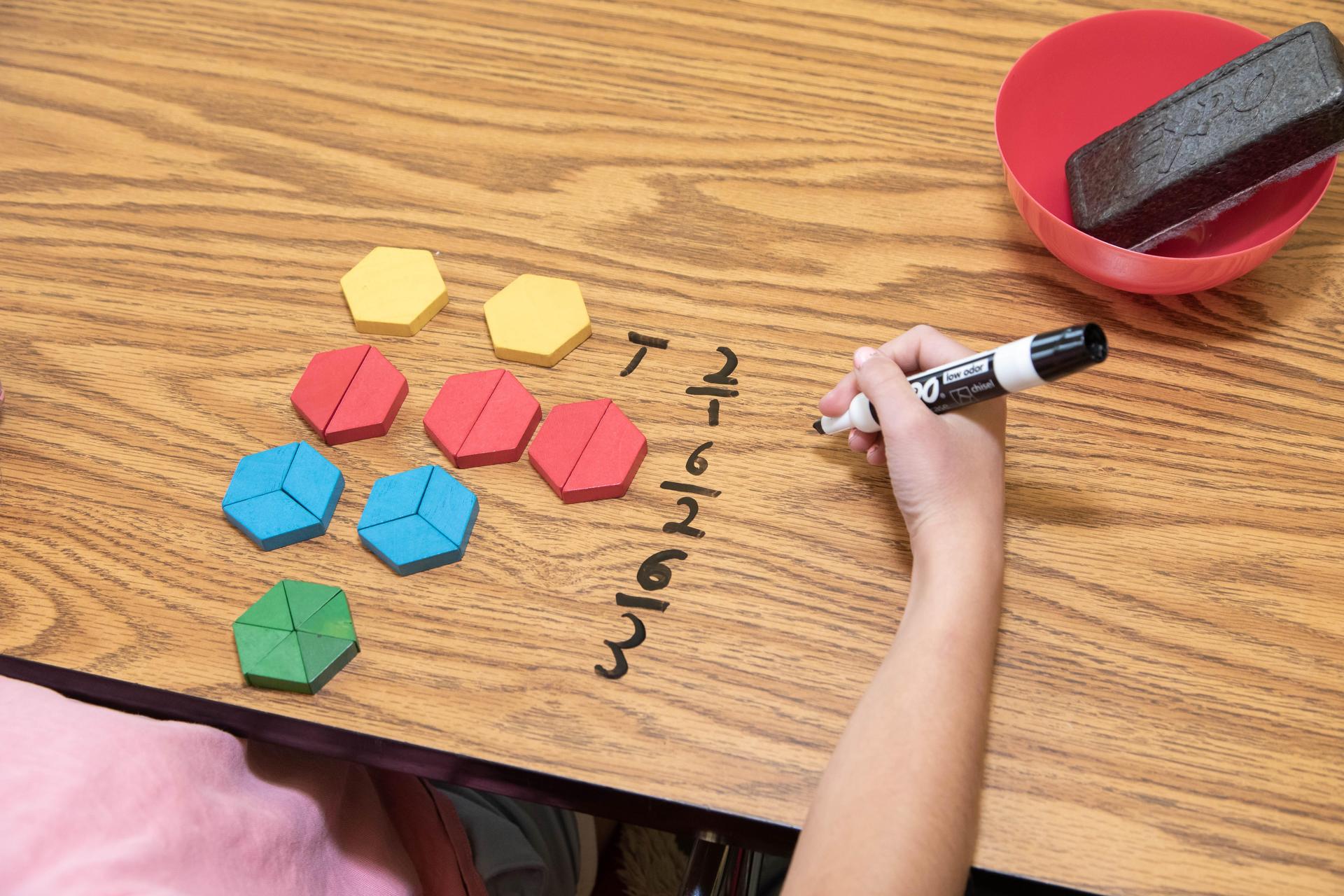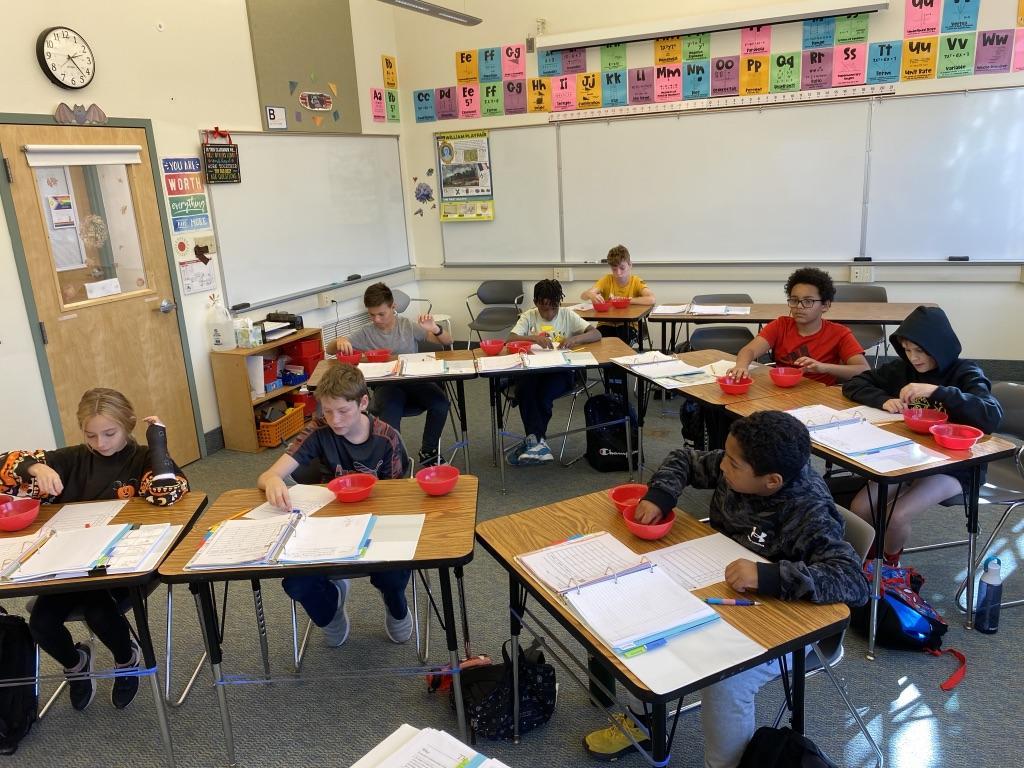Achieving Milestones in Multisensory Math
Middle School Math Teacher

These are the comments that teachers dream of hearing. These are the comments that echoed through my classroom once I changed my thinking about how best to help students achieve in math.
My training and experience were firmly rooted in traditional classrooms and approaches. Lots of drill and skill, workbooks full of pages and pages of algorithmic exercises, textbooks and lessons rife with abstract presentations. Graduate School in the nineties widened my view since it focused on the current understanding of how our brains learn, emphasizing strengthening neural connections through multiple methods of relaying information to support mastery of skills. Teaching chronically ill kids from a variety of school districts in a hospital setting showed me the far-reaching impact that gaps in understanding of basic skills can have on future attempts to learn a math concept.
When I started teaching at DVFriends, I was introduced to the Orton-Gillingham (O-G), a diagnostic-prescriptive approach to teaching language. I was given the opportunity to take a course in the math counterpart, Multisensory Math and it transformed my approach to lessons. The course was developed and taught by Marilyn Zecher. Multisensory Math is an approach that focuses on numeracy and automatic recognition of quantity and quantity relationships. It requires the use of explicit instruction; it uses the concrete, representational, and abstract instructional sequence; it highlights vertical thinking, whereby you review a basic concept or skill, then move to the current curricular point, and it offers repetition and practice to support automaticity rather than frustrating students with flashcards.
The research supports this approach:
- Number sense is the foundation for all higher-level mathematics (Feikes & Schwingendorf, 2008).
- The best way to develop fluency with numbers is to develop number sense and to work with numbers in different ways, not to blindly memorize without number sense (Boaler, 2015).
- In recent years brain researchers have found that the students who are most successful with number problems are those who are using different brain pathways – one that is numerical and symbolic and the other that involves more intuitive and spatial reasoning (Park & Brannon, 2013).
- Strategic solving and memorization involve two distinct pathways in the brain and both pathways are perfectly good for lifelong use. Importantly, the study also found that those who learned through strategies achieved ‘superior performance’ over those who memorized; they not only solved problems at the same speed but also showed better transfer to new problems. The brain researchers concluded that automaticity should be reached through an understanding of numerical relations, achieved through thinking about number strategies (Delazer et al, 2005).
Armed with this knowledge and research-based techniques for instruction, I waded into the shallow-end of the Multisensory Math  pool with my students. It was exciting to have more tools to help them grasp more abstract concepts (for example, that tricky topic of fractions). I quickly learned that approaching math in a multisensory manner does not just mean using manipulatives in the classroom. The manipulatives are just one tool in a whole set of strategies and approaches that more deeply engage students so that they not only understand the concepts better but can retain and reapply them over time.
pool with my students. It was exciting to have more tools to help them grasp more abstract concepts (for example, that tricky topic of fractions). I quickly learned that approaching math in a multisensory manner does not just mean using manipulatives in the classroom. The manipulatives are just one tool in a whole set of strategies and approaches that more deeply engage students so that they not only understand the concepts better but can retain and reapply them over time.
The key to unlocking all of math is numeracy. Numeracy is an understanding of the value or worth of a number or quantity. Without it, students are merely moving digits through an algorithm, not associating any meaning to their computations or solutions.
 Subitizing, or recognizing a quantity without counting, supports improved numeracy. In the classroom, my students create a reference sheet of the pip patterns found on dominoes from 1 through 12. We refer to it often, use the patterns to create math problems, and organize other manipulatives used throughout the course in the same fashion.It makes use of the O-G principles of teaching in a way that is structured, sequential, cumulative, and thorough.
Subitizing, or recognizing a quantity without counting, supports improved numeracy. In the classroom, my students create a reference sheet of the pip patterns found on dominoes from 1 through 12. We refer to it often, use the patterns to create math problems, and organize other manipulatives used throughout the course in the same fashion.It makes use of the O-G principles of teaching in a way that is structured, sequential, cumulative, and thorough.
Once I fully embraced the principles and incorporated them into my lesson plans, the results were slow but steady. At first, the students enjoyed the activities, commenting on how the class differed from their previous math courses. They would start to make connections on their own, leading to the next level of complexity for the skill. Some of my students were hesitant about embracing this new method at first. Since we invested so much time on numeracy under the heading of “Place Value”, and the students were accustomed to a quicker pace, there were a few questions and comments wondering just how long before we would move onto the next unit.
 It wasn’t long until my students and I discovered the benefits of the time investment. We have been able to sail through operations with whole numbers and decimals because there is now meaning behind the digits. Once students become very familiar with the facts through 10, it’s easier for them to extend facts out through millions. Familiarity with the tools of base ten blocks and craft sticks to show quantities allows these manipulatives to be used efficiently to demonstrate regrouping. Sharing consistent and explicit language to work through an algorithm provides the framework for students to perform multi-step problems independently, all of which are the building blocks to solve algebraic equations down the road.
It wasn’t long until my students and I discovered the benefits of the time investment. We have been able to sail through operations with whole numbers and decimals because there is now meaning behind the digits. Once students become very familiar with the facts through 10, it’s easier for them to extend facts out through millions. Familiarity with the tools of base ten blocks and craft sticks to show quantities allows these manipulatives to be used efficiently to demonstrate regrouping. Sharing consistent and explicit language to work through an algorithm provides the framework for students to perform multi-step problems independently, all of which are the building blocks to solve algebraic equations down the road.
Since my initial experiments with a multisensory curriculum in math, all of our lower and middle school teachers have taken the training in this approach and we have maintained a professional partnership with Marilyn Zecher as a resource for our team. Our students in both the lower and middle school divisions have greatly benefitted from this approach, and we continue to take the principles we learned in training and adapt them to our students specific needs and lessons. Just as Orton-Gillingham was a game-changing approach for students with challenges in reading and literacy, multisensory math has been a gamechanger for our students who have previously struggled in math.
Reflecting on the experience and results, I am encouraged by the change in my mindset as a math educator. I have been empowered by thinking “outside the book” and am now crafting a scope and sequence aimed at helping students develop a deeper understanding of concepts, rather than a checklist of skills to plow through in a given year. The change from an “all or nothing” approach of teaching skills in isolation to integrating skills throughout all units, and providing opportunities to use them in real-world contexts, has been reinvigorating for me. It is no longer “one and done, check it off the list.” Instead, mastery of the basics supporting meaningful carry-through knowledge is opening doors to the higher-level courses for all students.
REFERENCES:
- Boaler, J., Williams, C., Confer, A. (2015). Fluency Without Fear: Research Evidence on the Best Ways to Learn Math Facts
- Dehaene, S. (2011). The Number Sense: How the Mind Creates Mathematics
- Delazer, M., Ischebeck, A., Domahs, F., Zamarian, L., Koppelstaetter, F., Siedentopf, C.M. Kaufmann; Benke, T., & Felber, S. (2005). Learning by Strategies and Learning by Drill – evidence from an fMRI study. NeuroImage. 839-849
- Feikes, D. & Schwingendorf, K. (2008). The Importance of Compression in Children’s Learning of Mathematics and Teacher’s Learning to Teach Mathematics. Mediterranean Journal for Research in Mathematics Education 7 (2).
- Park, J. & Brannon, E. (2013). Training the Approximate Number System Improves Math Proficiency. Association for Psychological Science, 1-7
- Zecher, M. (2013) Multisensory Math: A Resource Manual of Hands-on Strategies for Teaching All Kinds of Learners